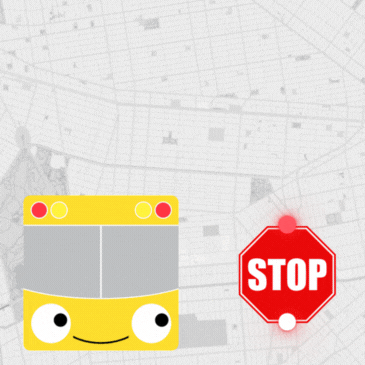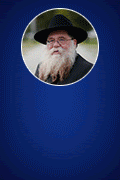which recently celebrated its first anniversary.
'High-tech and cool.'
A small, hidden door in the stage slowly opened opposite the seats packed with children (all of Korean heritage) and dozens of excited faces fixed on it, eager for a first glimpse of the master of ceremonies of this game with the mysterious name. A few seconds later, the mystery man burst into the studio. He was a short, young, bearded fellow with a purple skullcap and a Madonna-style microphone attached to his head, wearing black jeans and a white shirt with his long tzitzit (fringes) sticking out. He stood center-stage, taking in all the dropped jaws and wide-eyed faces. He smiled. The audience was his.
Torahs ‘R’ Us
which recently celebrated its first anniversary.
‘High-tech and cool.’
About 50 pairs of confused eyes tried to identify the source of the sonorous and authoritative voice addressing them from state-of-the-art loudspeakers hung on the walls of the dimly lit auditorium. Colorful scenery – balconies, a stage, podia with electronic buttons and a giant screen – imparted to the auditorium in the Jewish Children’s Museum in the Brooklyn neighborhood of Crown Heights the look of a television game-show studio. “Boys and girls, welcome to the game show you’ve been waiting for!” the voice thundered. “Welcome to ‘Torah Concentration!’”
A small, hidden door in the stage slowly opened opposite the seats packed with children (all of Korean heritage) and dozens of excited faces fixed on it, eager for a first glimpse of the master of ceremonies of this game with the mysterious name. A few seconds later, the mystery man burst into the studio. He was a short, young, bearded fellow with a purple skullcap and a Madonna-style microphone attached to his head, wearing black jeans and a white shirt with his long tzitzit (fringes) sticking out. He stood center-stage, taking in all the dropped jaws and wide-eyed faces. He smiled. The audience was his.
The young man, Shmuel Margolin, 20, from Virginia, quickly explained the rules. “You know the memory game?” he asked the kids, who ranged in age from four to 13 and had been brought to the museum by the new Korean Methodist Church in Flushing, Queens. The kids all shouted, “Yes!” “Well this game is almost the same thing,” Margolin continued. “But here we have Jewish symbols hiding behind the numbers on the game board. Okay, who will be my four volunteers? I need two contestants for each team.”
The Jewish Children’s Museum, which celebrated its first anniversary a couple of weeks ago, may not be the only Jewish children’s museum in the world, but it is certainly the largest and most expensive one of its kind, with an investment of some $31 million dollars. The budget came from donations from the Jewish world and from allocations from the State of New York and the federal government. Originally conceived by Chabad Lubavitch, the museum was built not far from the movement’s international headquarters at 770 Eastern Parkway.
“Our goal,” says the museum’s acting director, Rabbi Shalom Ber Baumgarten, “is to teach Jewish children about their history, tradition and values, and also to educate non-Jewish children about Judaism, to promote tolerance and fight anti-Semitism.”
Faithful to the emphasis the Lubavitcher Rebbe placed on educating the young generation, Chabad Hasidim began working on the museum project back in 1986. That year, for the first time, they staged the Great Jewish Children’s Expo at the Jacob Javits Convention Center in Manhattan, an event that drew thousands of people. For five years in a row, the Hasidim staged the fair in which they presented different aspects of Jewish history and heritage. At its peak, the exposition drew 75,000 people in one week.
Rabbi Baumgarten says that after a few years, the Chabad people realized that even the 15,000 square meters of rented space in Manhattan wasn’t enough to satisfy the movement’s ambitious goals. The natural development was to establish a permanent home for their ideas and exhibits – a big, modern museum.
The museum currently has a staff of 40, most of whom are Chabad Hasidim from Crown Heights. Chaim Benjaminson, the museum’s young marketing director, says that about 250 people visit the place each weekday and that on Sundays, the number goes up to 500. He adds that since the museum opened to the general public, it has had about 180,000 visitors. Each visitor pays a $10 entrance fee, and there are no discounts for large families.
Ancient traditions
In the “Torah Concentration” game led by Margolin on the museum’s lower level, the drama was underway. Margolin announced that the kids in the seats to the right of the stage would be one team, and the kids on the left would be the second team. He asked for two volunteers from each group and dozens of skinny hands waved in the air. Behind the right podium, on stage in front of their friends in the audience, stood Kyu Lee, 12, and Brian, 8. Behind the left podium stood Paul and Josh, both 12. On the wall opposite the audience 24 numbers glowed on a giant screen.
A loud gong sounded and the game began. Kyu Lee chose number 22, which flipped around to reveal “the chai symbol, which in Jewish tradition, represents life,” as Margolin quickly explained. The girl’s next choice was the number nine. Margolin pressed the button that made the number flip around, revealing a menorah “which represents the Hanukkah holiday.” Unfortunately for Kyu Lee and Brian, the two symbols did not match, so it was Paul and Josh’s turn. By the time they matched all the pictures hiding behind the numbers, the Korean-American youngsters would become acquainted with dreidels, hamentaschen and Lag Ba’omer bonfires, among other things.
“This place is high-tech and cool,” said Stanley Kang, 13, still excited by his team’s victory in the game show. “I learned about schools for learning Torah, about Shabbat and about the creation, and it was surprising and interesting. I was surprised because I’d never learned about these things and because they’re different from my religion. I hadn’t met any Jews before, even though I knew there were Jews in the world.”
In the hours that the kids from the Korean Methodist Church were at the museum, they were exposed to a whole array of ancient traditions and unfamiliar customs. They passed through “the World of Good,” where they could put a coin into a special pinball machine and send a colorful ball on a convoluted journey to the charity of their choice at the end. They went into phone booths and picked up the receivers to hear people speaking wickedly about one another, and thereby learned about the ruinous power of gossip.
The children discovered that on Yom Kippur, Jews only wear shoes made of fabric or rubber and never of leather. They saw what God did on each of the days of creation and stared in awe at an ultra-Orthodox version of Adam and Eve – two mannequins covered up to their necks in plastic fig leaves. Then they used ultraviolet flashlights to search for bits of chametz in cupboards. Some also crawled into a hole drilled into a giant challah. Next to it, on a giant-size Shabbat table, they sat down before a model of a huge bowl of matza ball soup. They got the message: Jews really, really love food. The visitors looked happy and were clearly enjoying themselves.
Real barcode scanners
A few days later, one Sunday in early March, it was hard to find any non-Jewish visitors in the museum. Dozens of Jewish families – from all over the religious spectrum – had packed in to see the different exhibits. Unquestionably, the biggest draw was something called “The Kosher Supermarket.”
In the exhibit, a small-scale reconstruction of a real supermarket, children learn about shopping for groceries and planning meals in accordance with halakha. They pick play items off the shelves and put them in their tiny shopping carts. In the checkout lines, equipped with real barcode scanners, they’re asked to scan only the meat items for a meat meal or only the dairy items for a dairy meal. At the same time, they also learn that things like fruit and vegetables are considered parve and may be integrated into either kind of meal. The screen on the cash register informs them right away if they are keeping the rules of kashrut.
“I think everyone who comes here feels wanted,” says Dr. Robert Rothstein, a 38-year-old ophthalmologist from Queens who describes himself as modern Orthodox. “You don’t see anything isolating. There’s nothing here that says, ‘We’re better than this or that group,’” he says when asked if he feels comfortable in a museum designed according to the outlook of Chabad Hasidim. Rothstein, keeping his eyes glued on his 3-year-old son who was scampering ecstatically around the kosher supermarket, emphasized that the museum’s importance lay in the way it enabled non-religious Jewish-American families “to understand Jewish values.”
In the kosher kitchen next to the supermarket, one of the museum’s guides, Goldie Hazdan, 22, was trying to teach a few toddlers about the importance of keeping meat dishes separate from dairy dishes. Hazdan, whose family runs a Chabad house in Johannesburg, South Africa, came to Crown Heights to be strengthened by the proximity to the legendary home of the Lubavitcher Rebbe.
“Try to put these two plates one on top of the other,” Hazdan gently prodded a little boy of about four, as she handed him a green plate, which was supposed to be dairy, and a red plate, supposed to be for meat. Opposing magnets were affixed to the bottom of each plate, and when the youngster tried to put them together, they seemed to magically push away from each other. “It’s impossible to put them together, because one is for meat and the other is for milk,” Hazdan explained with an endearing smile to a wide-eyed child. “These dishes just don’t go together.”
“We don’t only try to teach the kids here about the importance of keeping kosher, but also about how important it is to help their mom with the shopping, so they’ll also learn to wait patiently at the checkout line,” Hazdan explained.
Stations in life
Compared to the hustle and bustle at the kosher supermarket, the miniature golf course on the fifth-floor terrace is practically deserted. Only a few very hardy types were willing to brave the freezing wind that Sunday to enjoy this particular educational experience. As they pass from one hole to another on the lavishly designed course, miniature golfers learn about the most important stations in the life of a devout Jew.
On the first hole, the ball has to pass through play blocks, which symbolize the first years of life. Then the golfers pass by a model of tzitzit and tefillin (phylacteries), which symbolize the acceptance of the burden of observing the commandments, and right after that, they must send the ball under a white wedding canopy. You finish the course by propelling the ball beneath a life-size model of an old man on a rocking chair and into a hole situated next to a tombstone.
But later on, about a half hour before closing time, it was hard to find that same tranquil acceptance from the miniature golf course of life, not to mention the patience and tolerance and “Jewish values” that the museum seeks to instill in children. The “Passover holiday” wing looked like a battlefield. A small group of girls, no older than four or five, had gathered by the cabinet of kosher-for-Passover dishes, which somehow now included a pair of Keds sneakers plundered from the adjacent Yom Kippur exhibit. A little blonde girl clutched one of the ultraviolet flashlights, but instead of using it to try to find those elusive bits of chametz, she used it to smash a ceramic seder plate. Mission accomplished, she warily glanced right and left, stuck her hands into the pockets of her long dress, and nonchalantly strolled away from the scene of destruction she had just wreaked. She did not walk in the direction of the World of Good.













anonymous
wowow! This is all amazing!
typical haaretz
typical for their anti religious…
that last pragraph said it all…..realy corny,
i mean this is a CHILDRENS museum, and yes, kids DO break things. keep it up haaretz, you managed to stick something anti-religious into the article!